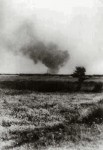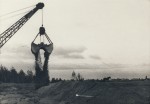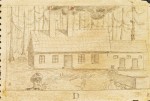 A team of archaeologists from the University of Birmingham have discovered new evidence of huge mass graves on the former site of the Nazi extermination camp Treblinka.
A team of archaeologists from the University of Birmingham have discovered new evidence of huge mass graves on the former site of the Nazi extermination camp Treblinka.
Since the Nazis razed the camp in November of 1943 after a prisoner revolt, leaving little visible evidence of the 800,000+ Jews they’d slaughtered in just over a year of operation, Holocaust deniers have claimed that Treblinka wasn’t a death camp at all, but rather a transit station where prisoners were sorted before being shipped off to other labor camps. (Interestingly, that’s just what the SS told new arrivals before making them undress and sending them to the “showers” for “delousing.”)
This is the first coordinated scientific attempt to locate graves at Treblinka. Led by forensic archaeologist Caroline Sturdy Colls, the research team used ground-penetrating radar and aerial and satellite imagery to look for burial sites without breaking ground, out of respect for Jewish Halacha law which forbids disturbing burial sites.
Sturdy Colls said: “All the history books state that Treblinka was destroyed by the Nazis but the survey has demonstrated that simply isn’t the case.”
She added: “I’ve identified a number of buried pits using geophysical techniques. These are considerable in size, and very deep, one in particular is 26 by 17 metres.”
 Dug by an enormous excavator from the quarry at the nearby Treblinka I forced labour camp, each of these large pits are thought to contain the charred remains of thousands of bodies. Some of the pits were used for burial, others as cremation pits. In March 1943, Heinrich Himmler visited the camp and ordered that all the bodies be cremated. The burial pits were opened and the corpses burned on cremation grates built out of railway tracks. There are pictures extant of the resulting ash heaps.
Dug by an enormous excavator from the quarry at the nearby Treblinka I forced labour camp, each of these large pits are thought to contain the charred remains of thousands of bodies. Some of the pits were used for burial, others as cremation pits. In March 1943, Heinrich Himmler visited the camp and ordered that all the bodies be cremated. The burial pits were opened and the corpses burned on cremation grates built out of railway tracks. There are pictures extant of the resulting ash heaps.
BBC Radio 4 will air a program following the Colls’ work at Treblinka. The Hidden Graves of the Holocaust first airs on Monday, January 23 at 8:00 PM.
A more personal witness to the horrors of the Holocaust can be found in a remarkable book recently published by the Auschwitz Memorial and Museum: The Sketchbook from Auschwitz. In 1947, Józef Odi, a former prisoner who was working as a watchman on the Auschwitz grounds, found 32 sketches on 22 pages rolled into a bottle and hidden in the foundations of a barracks near the gas chambers and crematoria.
These incredible works of art, beautiful and horrifying in equal measure, are the only drawings made in Birkenau to depict the extermination of Jews. They are signed with the initials MM, so we don’t even know the name of the artist. We know from some of the depictions that they were made in 1943 and that the artist was immensely courageous to make these detailed drawings recording the systematic mass-murder of Jews, including badge numbers of functionary prisoners, license plates of trucks and train cars.
This is the first time all of the MM sketches have been published.


